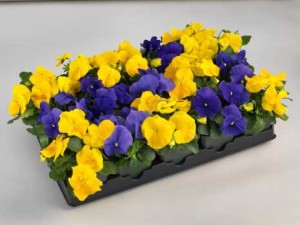Greenhouse Production Tips For A Successful Spring Pansy Crop

The Grandio Series (Sakata Ornamentals) is a large-flowered pansy series bred for today’s greenhouse production systems, as well as excellent garden performance in both spring and fall.
One of the first crops to flower and finish in spring bedding production programs are the bright and cheerful pansy mixes. Whether they are grown in packs, pots, baskets or mixed containers, pansies say winter is closing up and spring is coming in. But the early shipping weeks can bring warm and sunny days, immediately followed by a return of the cold. It’s a mixed bag of weather in many parts of the country. If grown and acclimated for the sometimes rapidly changing spring climate, pansy crops can withstand these adverse conditions if growers follow a few production and cultural protocols.
Starting It Right In The Plug Stage
When germinating pansy seeds, the most important environmental factor to consider is proper moisture management. Primed pansy seed usually takes only two to three days to germinate at 64°F to 67°F. Water in the plug trays to a level 5 (saturated) until radicle emergence. Once the cotyledons have expanded, water up to level 4 (wet) and allow plugs to dry down to level 3 (moist). Do not allow the plugs to stay overly wet, or become excessively dry. For maximum plug counts, this is the most critical phase of pansy plug production. It is not recommended to utilize a starter charge in the plug germination mix, as this may result in hypocotyl stretch and eventually in floppy transplants.
As the pansy plugs approach transplanting (four to five weeks depending on tray size), watering up to level 3 and drying to a level 2 (medium) can assist in toning the crop for finishing.
Remember: Pansies Are A Cool-Season Crop
By their very nature, pansy crops can withstand and actually perform much better when grown in cool greenhouse conditions. Finding a happy medium when determining at what average daily temperature (ADT) a pansy crop should be started and finished at will result in a well-toned, durable pansy crop.
Generally, a pansy crop can be finished easily with an ADT of 62°F to 65°F. However, if a grower is willing and able to drop the ADT into the mid to high 50s, the finished crop will end up very tough, with thick, dark-green leaves, and flowers sitting atop the foliage. An additional two to three weeks of production time may be needed when pansies are grown at cooler ADTs.
If pansies are finished at higher temperatures, such as with an ADT of 70°F or more, the tone will soften, with the habit more lush and open. The flower peduncles will stretch, and the overall look will appear stretched. As a result, the retail shelf life will shorten dramatically, and if the weather conditions do not allow for good store traffic, sell-through could be minimal.
Toughen Pansies With The Right Fertilizer Blend
When pansy crops are fed with high ammonium and phosphorous fertilizers, the results could be faster growth. Plants will come into bloom quickly, but overall appearance will decline. However, plants grown with calcium nitrate-based feeds with low phosphorous levels will result in strong, well-toned growth. Couple this with ADTs in the low 60s, and the pansy crop is well on its way to finishing for an extended retail shelf life. Fertilizers such as 15-3-30, 14-2-14 and 17-5-17 are some blends recommended for good sustained growth. Start with 50 to 75 ppm nitrogen (N) in the plug stages of growth, increasing to 100 to 150 ppm N after transplanting and approaching the pansy crop’s finish date.
Target The Ideal pH And EC Ranges
Pansy crops perform best when the ideal pH ranges allow for maximum nutrient uptake, especially iron. Pansies are not as efficient in taking up iron when the pH rises above 6. 2; therefore, a soil pH range of 5. 5 to 5. 8 is recommended. When soil pH is in the ideal range, and a good pansy feed is being applied, target the soil EC in the 1. 25 to 1. 5 range.
Pansy Diseases
A good grower axiom to follow is, ‘A healthy plant is a happy plant. ’ However, there are specific diseases that are particularly devastating to pansy crops, of which Thielaviopsis is one. An excellent preventative is to maintain the soil pH of all pansy crops in the ideal range of 5. 5 to 5. 8 and never allow the EC to rise above 1. 75. Eliminating the additional stress of these two factors will help prevent Thielaviopsis in nearly all cases.
Anthracnose and Alternaria are two foliar diseases that can also be seen on pansy crops during the cool and darker months of late winter and early spring. Keeping the foliage dry and providing good air ventilation, especially during the late afternoon and night, will help alleviate the onset of foliar disease. Preventative fungicides such as Heritage, Medallion and Chipco are also recommended during sustained dark conditions.










